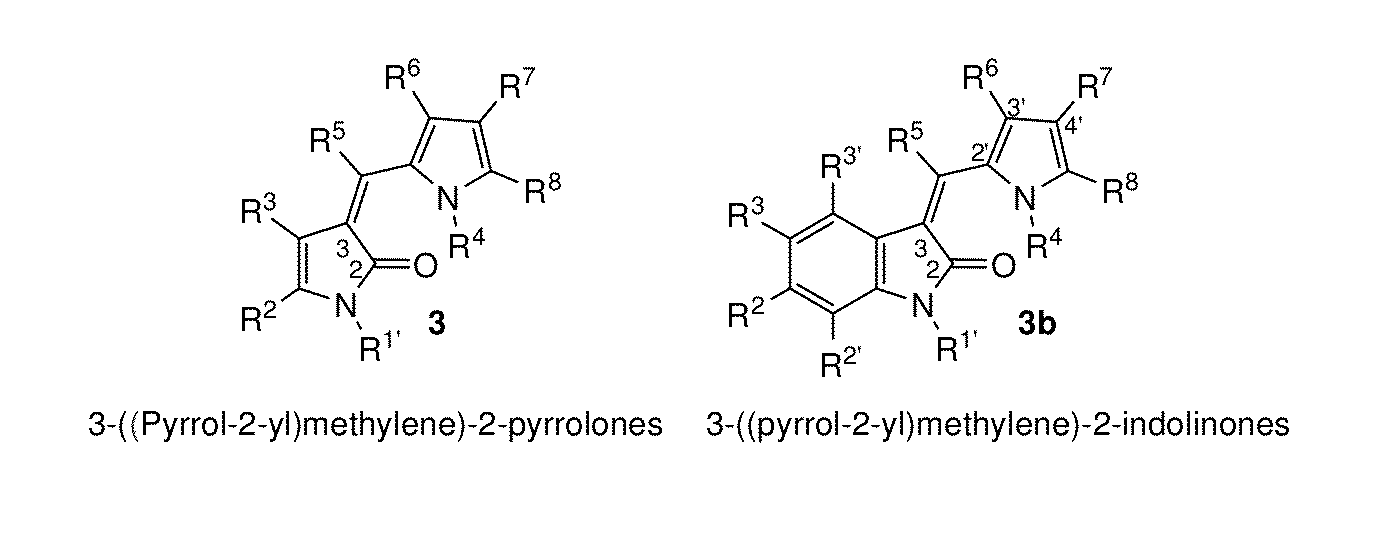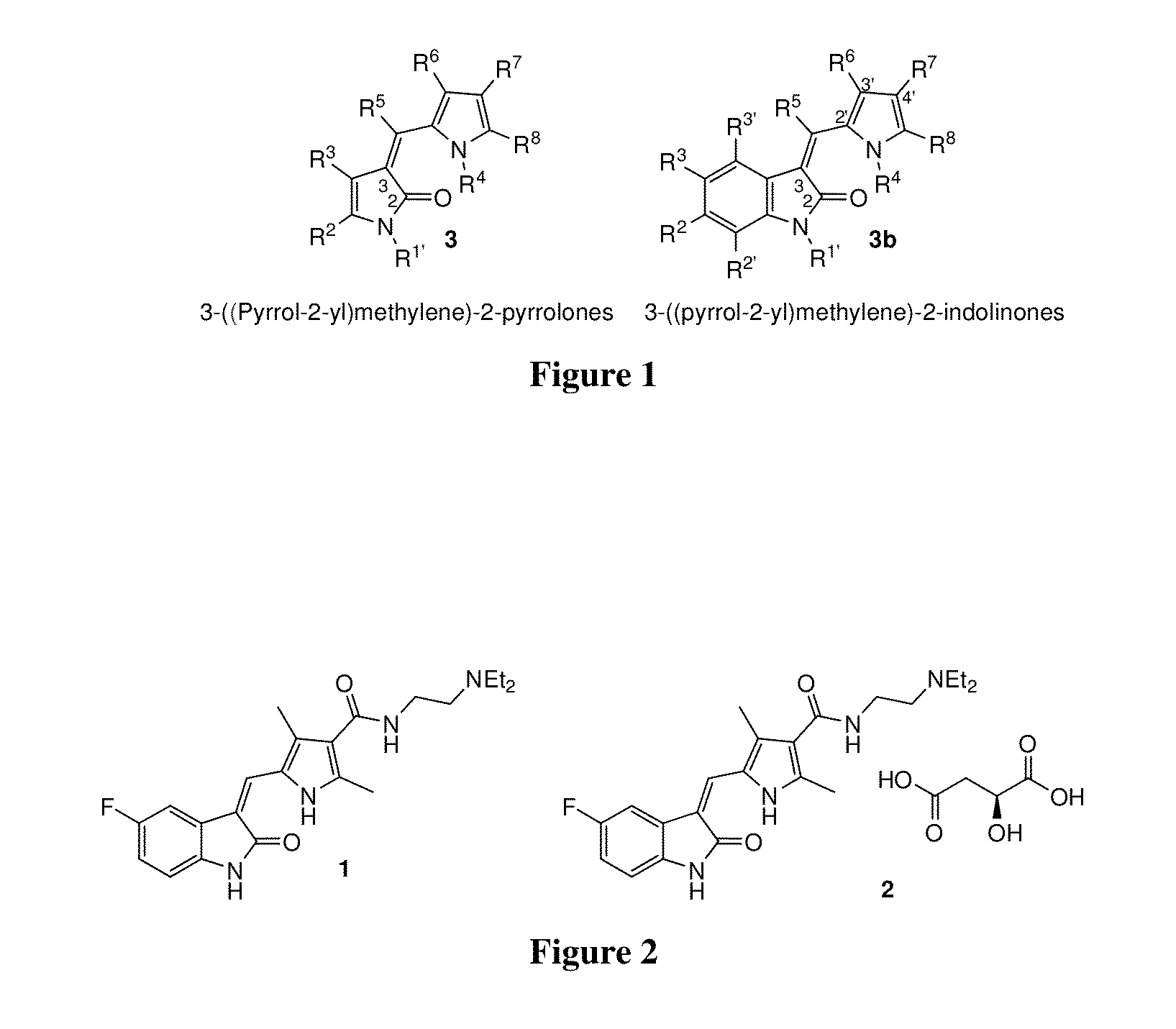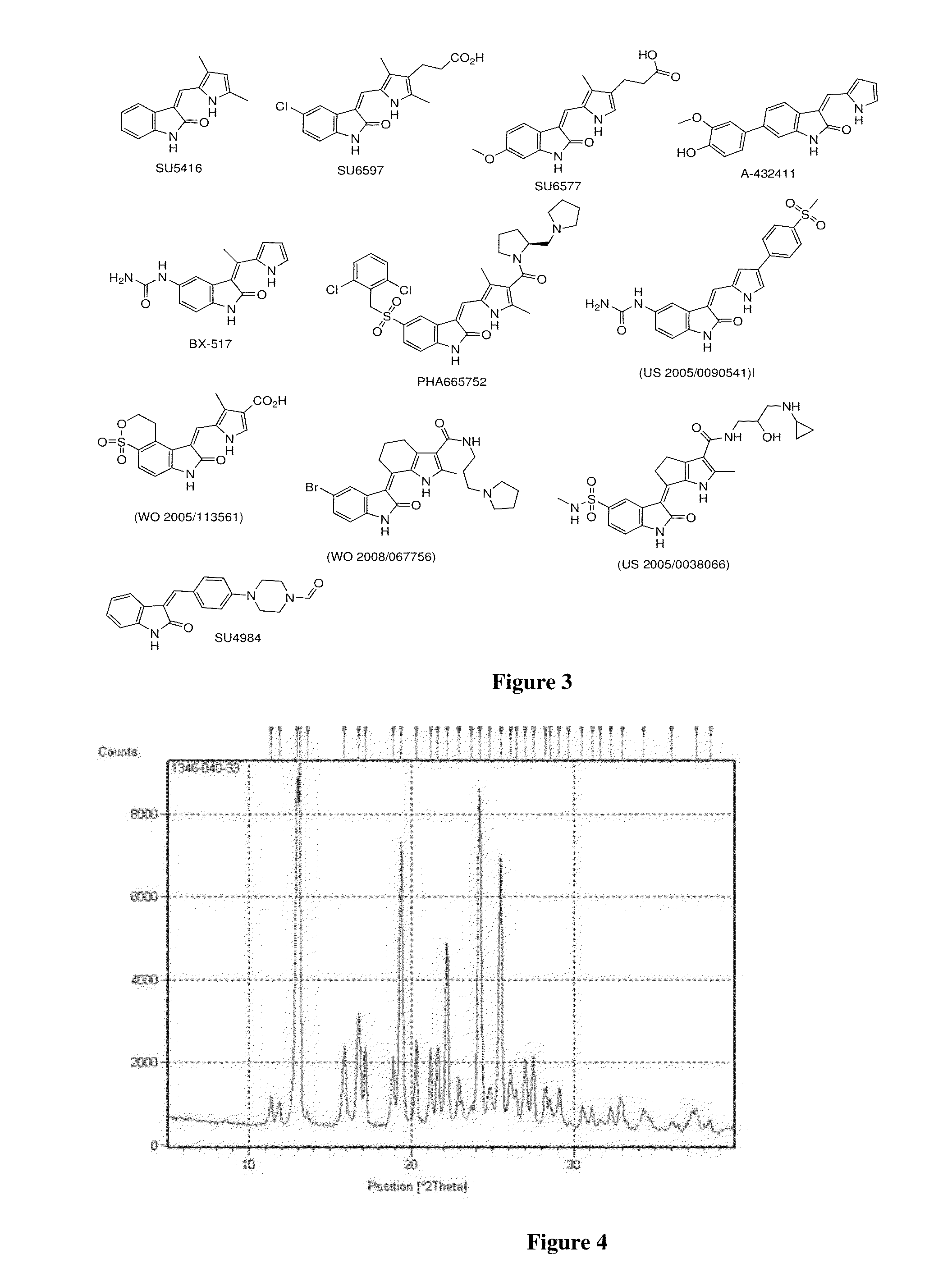Processes for the preparation of 3-(pyrrol-2-yl)methylene)-2-pyrrolones using 2-silyloxy-pyrroles
a technology of pyrrolone and pyrrolone, which is applied in the direction of organic chemistry, organic active ingredients, drug compositions, etc., can solve the problems of inefficient removal of impurities, ineffective purification, etc., and achieve the effect of avoiding the obtaining, isolation and processing of sunitinib base, reducing solubility profile, and being concis
- Summary
- Abstract
- Description
- Claims
- Application Information
AI Technical Summary
Benefits of technology
Problems solved by technology
Method used
Image
Examples
example 1
Two-Pot Synthesis of Sunitinib Base
[0058]Synthesis of Sunitinib Base:
[0059]Under N2, 5-fluoroindolin-2-one (8; 45.6 g, 0.301 mol, 1.0 eq.), (NH4)2SO4 (3.96 g, 0.030 mol, 0.1 eq.) and HMDS (437.2 g, 567.8 mL, 2.709 mol, 9.0 eq.) were charged into a flask with a magnetic stirrer and a thermometer at ambient temperature. The mixture was heated with stirring at reflux until the in-process control criterion was passed (7 to 8 h). The mixture was concentrated in vacuo (relative vacuum NLT 0.095 MPa) at about 60° C. until no further distillate was collected. The thus obtained crude 5-fluoro-1-(trimethylsilyl)-2-(trimethylsilyloxy)-1H-indole (20) was obtained and MeCN (1685 g, 2160 mL, 27 P w.r.t. N-(2-(diethylamino)ethyl)-5-formyl-2,4-dimethyl-1H-pyrrole-3-carboxamide (13)) were charged into a 5 L flask with a mechanical stirrer and a thermometer at ambient temperature, the mixture was stirred, and TMSOTf (13.38 g, 10.8 mL, 0.060 mol, 0.2 eq.) was added dropwise into the above mixture. The...
example 2
One-Pot Synthesis of Sunitinib Base
[0062]A 25 mL single neck flask was charged with 0.57 g (1.0 eq) of 8, 0.05 g (0.1 eq) of (NH4)2SO4 and 7.1 mL (9 eq.) of HMDS. The mixture was heated to reflux for 5 h to give a clear solution, then MeCN (21 mL) and 13 (0.93 g, 1.0 eq) were added followed by TMSOTf (127 μl, 0.2 eq) added dropwise over 0.5 min. The reaction mixture was heated to reflux for 29.3 h and was then cooled to room temperature and poured in to 50 mL saturated NaHCO3 solution. The slurry was stirred in an ice bath for 2 h and then filtered. The filter cake was washed with 50 mL water and then dried at 40° C. under vacuum for 8 hrs to give a yellow solid (1.24 g, 92.2% purity by HPLC) in 82% yield.
example 3
Two-Pot Synthesis of Sunitinib Base with 1 eq. of TMSOTf
[0063]A 25 mL single neck flask was charged with 0.57 g (1.0 eq) of 8, 0.05 g (0.1 eq) of (NH4)2SO4 and 7.1 mL (9 eq.) of HMDS. The mixture was heated to reflux for 5 hrs to give a clear solution, which was distilled at 60° C. under vacuum to remove the HMDS. The distillation residue, MeCN (28 mL, 30 P) and 13 (0.93 g, 1.0 eq) were added to a 50 mL three neck flask. Then TMSOTf (636 μl, 1.0 eq) was added dropwise over 0.5 min and the reaction mixture was heated to 45° C. for 4.9 h to pass the coupling in-process control criterion. The reaction mixture was cooled to room temperature and poured into 50 mL saturated NaHCO3 solution. The slurry was stirred in an ice bath for 2 h then filtered. Filter cake was washed with 50 mL water and then dried at 40° C. under vacuum for 8 h to give a yellow solid (1.19 g, 95.0 purity by HPLC) in 81% yield.
PUM
| Property | Measurement | Unit |
|---|---|---|
| temperature | aaaaa | aaaaa |
| temperature | aaaaa | aaaaa |
| temperatures | aaaaa | aaaaa |
Abstract
Description
Claims
Application Information
 Login to View More
Login to View More - R&D
- Intellectual Property
- Life Sciences
- Materials
- Tech Scout
- Unparalleled Data Quality
- Higher Quality Content
- 60% Fewer Hallucinations
Browse by: Latest US Patents, China's latest patents, Technical Efficacy Thesaurus, Application Domain, Technology Topic, Popular Technical Reports.
© 2025 PatSnap. All rights reserved.Legal|Privacy policy|Modern Slavery Act Transparency Statement|Sitemap|About US| Contact US: help@patsnap.com



